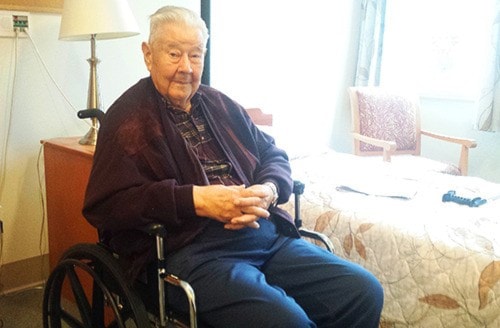As Remembrance Day draws near, the memories of the brave men and women who gave their lives in service to their country and who fought bravely side by side during World War II are still fresh.
Local war hero Jack Lawrence was born March 1 in 1919 and is one such gentleman who served in the Canadian army during the war. Jack shared his story with humour, intelligence and dignity, as The Hope Standard met up with him at Cheam Village in Agassiz, where he is recovering from a hip injury he sustained while on the golf course.
Jack was in good spirits with his long time partner Eleanor Collopy at his side, as he spoke of his harrowing ordeal during the war. Jack joined the military in 1940, at the age of 21, where he was sent to Vancouver for technical training. After completing certifications on the coast and several others in a myriad of places including Hamilton and Kingston, Ontario, where he studied at a penitentiary for anti-aircraft machine gun training, Jack found his way to Halifax where he boarded the Queen Elizabeth and headed overseas.
“We had to worry about submarines — it was a lightening fast trip in those days, and it took all of five days before they dumped us off in Scotland,” he said.
From there, Jack made his way to southern England, where he was posted on anti-aircraft duty to shoot down German planes. After determining that he needed more training, Jack went to London where he lived in a couple of barracks, before heading to New Castle for three months.
D-Day came on June 6, 1944, which marked the allied invasion of Normandy and Jack landed in Dieppe, France, where he fought his way to the border of Holland.
“There were a lot of funny deals,” he said of being front line infantry and navigating war terrain as a soldier.
It was there that the Germans captured him and three others, making Jack an official prisoner of war.
“We went two days with nothing to eat, and then we saw these great big German tanks with a huge Nazi sign — they were moving through the bush and knocking down trees,” he said.
Jack was shot on the right side of his face by the soldiers, before he was captured.
“I couldn’t feel anything on my left side, there was nothing but blood, and my jaw seemed not to work and I was moaning and groaning.”
Jack remembers carrying a wounded friend, after being ordered to pick the bloodied man off the ground. Jack’s reply in the face of all of this was simply, “are you going to shoot us now?”
There were dead bodies everywhere and the Germans were raising hell, as Jack did as he was told, with blood still coming out of his own jaw.
“If I didn’t drag the man along, they were going to shoot us, so we climbed on to one of the four tanks, and made it to a German first aid post — there was a big tent and the floor was covered with the wounded, at least 30 or 40.”
It was there that Jack’s friend was shot. He was then ordered to carry a wounded German soldier.
“I put my arm around him and it was like putting my arm around warm, wet meat. I twisted him around and we started walking, and this guy passed out, and he kept asking for wasser (water.)”
After taking the man out the back door of a room in the post, Jack was met with Canadian artillery, where he dove into a ditch for survival, and then continued walking with the wounded soldier.
“The guy was just about dead and we made it to the German line, and I knew it wouldn’t pay for us to run,” he said.
Jack comforted the wounded soldier with a cigarette from a pack of smokes he had in his uniform.
“At that point we were good buddies, and it seemed to make him happy to have a smoke.”
They eventually found higher ground and dried off, where Jack parted company with the man and was transported to a jail cell somewhere in Holland, where conditions were intolerable, cruel, dirty and inhumane.
“There was every type of nationality in there — there were around 400 wounded allies, amongst other prisoners.”
Jack was eventually transferred to another prisoner camp in Poland, where conditions were gruesome.
“Lice kept you warm. I saw a man with maggots on his arm, it has been shot off at the elbow. I eventually ended up working in a mine in western Germany, which was nice because it was warm underground,” he said. “It was 10 to 12 hours a day with a couple of slices of bread.
Eventually Jack saw his opportunity and escaped the prisoner camp, sometime after the war had been won by the allies. His escape involved starvation and sleeping in cemeteries until he was rescued by British soldiers.
After being deloused and fed, he made it to Antwerp and started living like a gentleman again.
“I made it back to Canada in 1945,” he told The Hope Standard, where he eventually married his first wife Vera and adopted his daughter Juanita.
In the face of his extraordinary journey, one that would leave most traumatized, Jack has lived an exemplary life, working for a railway company and becoming an established member of the Hope Legion and the local community.
“Jack is mellow — he was never the type of man to lose his temper,” said Eleanor.
Through his entire recollection of events, Jack remained smiling and with a twinkle in his eye, as if he knows or understands something far greater, than any of us, could ever imagine. Jack has been awarded several prestigious medals for his bravery during the war.
